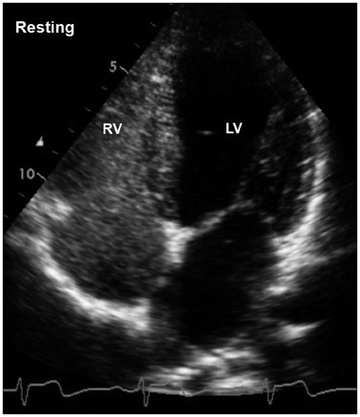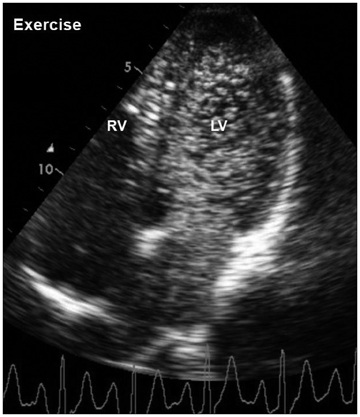J Cardiovasc Ultrasound.
2014 Jun;22(2):88-90. 10.4250/jcu.2014.22.2.88.
Exercise-Induced Intrapulmonary Arteriovenous Shunt in a Patient Complaining of Dyspnea during Strenuous Exercise
- Affiliations
-
- 1Division of Cardiology, Hallym Sacred Heart Hospital, Hallym University College of Medicine, Anyang, Korea. 237419@hallym.or.kr
- KMID: 2177466
- DOI: http://doi.org/10.4250/jcu.2014.22.2.88
Abstract
- A 51-year-old highly fit man presented for dyspnea with strenuous aerobic exercise. The patient was asymptomatic and all tests were normal at rest. With increasing exercise intensity, he suddenly complained of dyspnea and showed a severe exercise-induced hypoxemia with an excessive alveolar-arterial oxygen tension difference. In agitated saline contrast echocardiography at peak exercise, a large amount of left to right shunt was identified after > 5 cardiac cycles, which suggests the presence of exercise-induced intrapulmonary arteriovenous shunt in this patient.
MeSH Terms
Figure
Reference
-
1. Dempsey JA, Wagner PD. Exercise-induced arterial hypoxemia. J Appl Physiol (1985). 1999; 87:1997–2006.
Article2. Powers SK, Dodd S, Lawler J, Landry G, Kirtley M, McKnight T, Grinton S. Incidence of exercise induced hypoxemia in elite endurance athletes at sea level. Eur J Appl Physiol Occup Physiol. 1988; 58:298–302.
Article3. Wagner PD, Gale GE, Moon RE, Torre-Bueno JR, Stolp BW, Saltzman HA. Pulmonary gas exchange in humans exercising at sea level and simulated altitude. J Appl Physiol (1985). 1986; 61:260–270.
Article4. Vogiatzis I, Zakynthinos S, Boushel R, Athanasopoulos D, Guenette JA, Wagner H, Roussos C, Wagner PD. The contribution of intrapulmonary shunts to the alveolar-to-arterial oxygen difference during exercise is very small. J Physiol. 2008; 586:2381–2391.
Article5. Lovering AT, Stickland MK, Kelso AJ, Eldridge MW. Direct demonstration of 25- and 50-microm arteriovenous pathways in healthy human and baboon lungs. Am J Physiol Heart Circ Physiol. 2007; 292:H1777–H1781.6. Stickland MK, Lovering AT. Exercise-induced intrapulmonary arteriovenous shunting and pulmonary gas exchange. Exerc Sport Sci Rev. 2006; 34:99–106.
Article7. Laurie SS, Yang X, Elliott JE, Beasley KM, Lovering AT. Hypoxiainduced intrapulmonary arteriovenous shunting at rest in healthy humans. J Appl Physiol (1985). 2010; 109:1072–1079.
Article
- Full Text Links
- Actions
-
Cited
- CITED
-
- Close
- Share
- Similar articles
-
- Anesthetic Care for a Patient with a Pulmonary Arteriovenous Malformation Undergoing Brain Abscess Removal and Pulmonary Lobectomy: A case report
- Effects of Resveratrol Supplementation on Oxidative Damage and Lipid Peroxidation Induced by Strenuous Exercise in Rats
- A Case of Exercise-Induced Hematuria Presenting as Gross Hematuria Lasting One Week
- A case of exercise-induced anaphylaxis in an asthmatic patient
- Osteoporosis




